Introduction
Imagine standing in a city where history hums through cobblestone streets, where every café holds secrets whispered by kings, and where the air is laced with the aroma of freshly brewed espresso mingled with the faint sweetness of chocolate. Welcome to Turin, or Torino as the locals affectionately call it—a city where elegance, history, and modern vibrancy converge beneath the shadow of the Alps.
Unlike the boisterous energy of Rome or the romantic canals of Venice, Turin charms you quietly, like a book you can’t put down. The moment you arrive, you’ll notice the city’s refined beauty: tree-lined boulevards, stately baroque palaces, and arcaded streets that seem to stretch endlessly. The Alps, standing tall and proud in the distance, add a dramatic backdrop, especially when dusted with snow in the winter months. It’s hard not to be captivated by this understated gem in northern Italy.
But history is just one layer of Turin’s charm. This city is also a culinary paradise. Turin gave the world gianduja, a heavenly mix of chocolate and hazelnut that inspired Nutella. It’s the birthplace of vermouth and home to the beloved aperitivo tradition, where evenings begin with drinks and delectable nibbles. Don’t leave without indulging in a bicerin, a decadent drink of espresso, chocolate, and cream that perfectly embodies Turin’s love affair with flavor.
A Brief History of Turin
Turin’s story begins over two millennia ago when it was established as Augusta Taurinorum by the Romans in 28 BCE. Positioned at the crossroads of major trade routes, it became a strategic military settlement. While much of ancient Rome’s physical presence in Turin has faded with time, some remnants, like the majestic Porta Palatina, still stand as a testament to the city’s classical origins. Even the grid-like street layout in the city center today reflects its Roman foundation.

After the fall of the Roman Empire, Turin transformed into a Lombard stronghold during the early Middle Ages, a period when it was fortified against invading forces. By the 11th century, the city found itself under the rule of the Counts of Savoy, a dynasty that would shape its destiny for centuries to come. Under Savoy leadership, Turin began its journey from a modest provincial town to a center of power and culture in Italy.
The 18th century saw Turin take on even greater importance. Under King Victor Amadeus II, the House of Savoy expanded its influence, and Turin became a hub of Enlightenment thought and architectural innovation. The city’s signature baroque style flourished, with buildings like the Basilica di Superga, designed by Filippo Juvarra, emerging as iconic symbols of this era. Meanwhile, Turin’s coffeehouses became lively gathering places for intellectuals, artists, and revolutionaries.
In every corner of Turin, the past whispers its stories. From the Roman gates to the regal boulevards, Turin’s history is one of resilience, innovation, and transformation—a city that has continually redefined itself while holding onto the elegance and charm of its roots.
Why You Should Visit Turin
Turin is a city that effortlessly blends history, culinary brilliance, and scenic beauty, all with a touch of Alpine elegance. Its unique charm makes it a destination you simply can’t miss.

Historical richness
Turin’s past is woven into its streets and landmarks. Stroll through Piazza Castello, where the regal Palazzo Reale and Palazzo Madama stand as reminders of the city’s time as the capital of the House of Savoy. Dive deeper into its Roman roots at the Porta Palatina, a remarkably preserved gate from ancient times. For panoramic views and a touch of history, visit the Basilica of Superga, perched high above the city.
Culinary excellence
Turin is a haven for food lovers. Start with a sip of bicerin, a rich mix of espresso, chocolate, and cream, at the historic Caffè Al Bicerin. Indulge in local delights like agnolotti del plin, delicate pasta parcels, or explore Turin’s famous aperitivo culture in Piazza Vittorio Veneto. Don’t forget to visit a chocolate shop to sample gianduja, Turin’s legendary hazelnut chocolate. For fresh produce and local specialties, head to Porta Palazzo Market, Europe’s largest open-air market.
Scenic beauty
Framed by the Alps and the Po River, Turin is stunningly picturesque. Wander through Parco del Valentino, a riverside park that features the charming Borgo Medievale, or climb to Monte dei Cappuccini for breathtaking views of the city and its Alpine backdrop.
Whether you’re drawn by its regal history, world-class cuisine, or natural beauty, Turin promises an experience filled with elegance and discovery. It’s a city where every moment feels timeless.
Iconic Landmarks You Can’t Miss in Turin
Turin is a city where history, elegance, and culture come together in perfect harmony. From its regal palaces to its distinctive landmarks, each site tells a story that defines this enchanting destination. Here’s a guide to Turin’s most iconic landmarks, along with their locations to help you explore with ease.

Piazza Castello
At the heart of Turin lies Piazza Castello, a grand square that showcases the city’s rich history and architectural beauty. Surrounded by notable landmarks, including the Palazzo Reale and Palazzo Madama, this square offers visitors a glimpse into Turin’s royal past. Stroll along its wide paths, admire the fountains, or simply enjoy the lively atmosphere that makes it a central meeting point for locals and tourists alike.
Location: Piazza Castello, Turin City Center
Mole Antonelliana
The Mole Antonelliana is Turin’s most iconic symbol and a must-see attraction. Originally designed as a synagogue in the 19th century, it now houses the National Cinema Museum, which offers fascinating exhibits on the history of film. The building’s unique spire is visible from across the city, and visitors can take an elevator to the top for breathtaking panoramic views of Turin and the surrounding Alps.
Location: Via Montebello, 20
Palazzo Reale
The Palazzo Reale, or Royal Palace, is a masterpiece of baroque architecture that was once home to the powerful House of Savoy. Visitors can wander through its opulent interiors, which feature gilded rooms, stunning frescoes, and period furnishings. The adjacent Armeria Reale (Royal Armoury) boasts an impressive collection of weapons and armor, while the palace gardens offer a peaceful retreat.
Location: Piazzetta Reale, 1
Egyptian Museum
The Egyptian Museum in Turin is the second-largest museum of Egyptian artifacts in the world, after Cairo. Its vast collection includes over 30,000 items, from ancient statues and sarcophagi to beautifully preserved papyri and everyday objects. Highlights include the Tomb of Kha and statues of the goddess Sekhmet, making it a must-visit for history enthusiasts.
Location: Via Accademia delle Scienze, 6

Basilica of Superga
Perched on a hill overlooking the city, the Basilica of Superga offers one of Turin’s most stunning views. Designed by architect Filippo Juvarra in the early 18th century, this baroque masterpiece serves as the final resting place for members of the House of Savoy. The basilica is also known for its connection to the tragic 1949 plane crash that claimed the lives of the Torino football team. Visitors can tour its ornate interior and climb the dome for sweeping views of Turin and the Alps.
Location: Strada Basilica di Superga, 73
Porta Palatina
The Porta Palatina is a remarkable remnant of Turin’s Roman past and one of the best-preserved Roman gates in northern Italy. Built during the 1st century BCE, this ancient red-brick structure once served as the main entrance to Augusta Taurinorum, the Roman settlement that became Turin. Today, it stands proudly near the city center, surrounded by archaeological ruins that offer a glimpse into Turin’s ancient history.
Location: Piazza Cesare Augusto
Parco del Valentino and Borgo Medievale
Nestled along the Po River, Parco del Valentino is Turin’s most famous park and a favorite spot for locals and visitors alike. Its expansive green spaces are perfect for picnics and leisurely strolls. Within the park lies the Borgo Medievale, a charming reconstruction of a 15th-century medieval village, complete with a castle, artisan workshops, and cobblestone streets. It’s a whimsical and peaceful escape from the city’s hustle.
Location: Corso Massimo d’Azeglio
Cathedral of San Giovanni Battista and the Shroud of Turin
Turin’s main cathedral, the Cathedral of San Giovanni Battista, is a Renaissance gem dedicated to John the Baptist. It houses one of Christianity’s most famous relics—the Shroud of Turin, believed by some to bear the image of Christ. While the actual shroud is rarely on display, visitors can learn about its history and significance through exhibits in the cathedral. The tranquil atmosphere and beautiful chapels make this a spiritual and historical highlight of Turin.
Location: Piazza San Giovanni
National Automobile Museum
Turin’s role as Italy’s automotive capital comes to life at the Museo Nazionale dell’Automobile. This museum celebrates the history of cars, from early prototypes to modern supercars, with over 200 vehicles on display. Interactive exhibits and multimedia installations make it an engaging and educational experience for visitors of all ages.
Location: Corso Unità d’Italia, 40
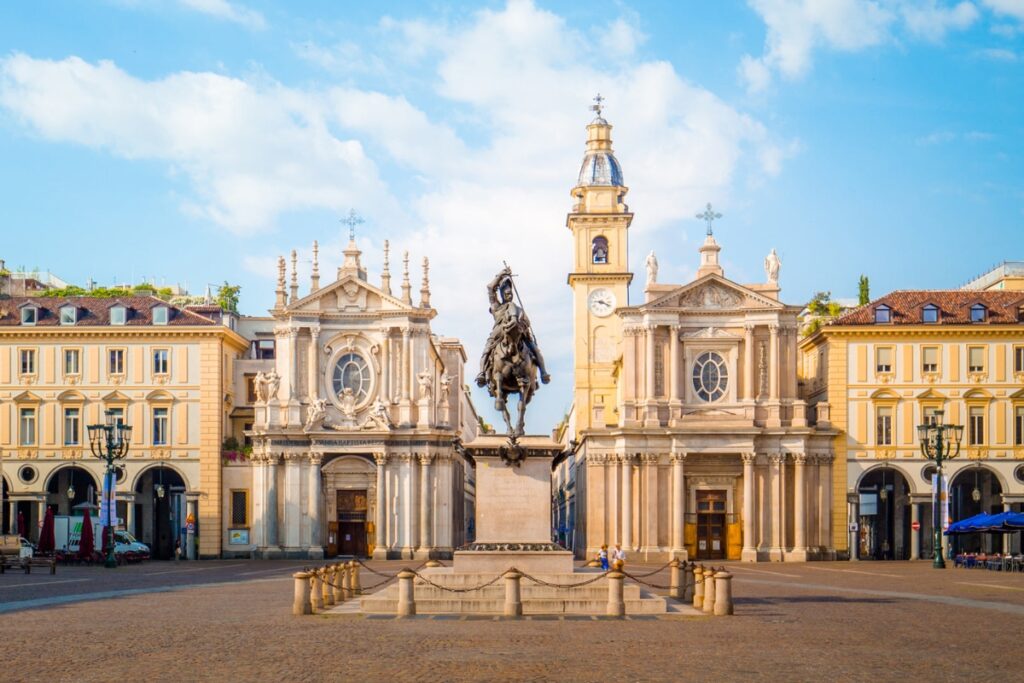
Piazza San Carlo
Known as the “drawing room” of Turin, Piazza San Carlo is one of the city’s most elegant squares. It’s framed by two twin baroque churches—Santa Cristina and San Carlo Borromeo—and features the striking equestrian statue of Emmanuel Philibert at its center. Historic cafes like Caffè Torino and Caffè San Carlo line the square, offering the perfect setting to enjoy a coffee and people-watch.
Location: Piazza San Carlo, Turin City Center
Turin’s iconic landmarks offer a perfect blend of history, culture, and beauty. From its regal palaces to its modern museums, each site adds to the city’s charm and allure. Whether you’re admiring the Mole Antonelliana’s spire, walking through the Roman Porta Palatina, or relaxing in Parco del Valentino, Turin promises an unforgettable journey through time and elegance.
Hidden Gems in Turin: Exploring the City’s Best-Kept Secrets
Turin is a city that rewards the curious traveler. Beyond its famous landmarks lies a treasure trove of hidden gems that reveal its authentic charm, unique history, and creative spirit. Here’s a guide to uncovering the lesser-known wonders of Turin, with their locations to help you explore effortlessly.

Quadrilatero Romano
Tucked away in the heart of Turin, the Quadrilatero Romano is a historic district bursting with character. This area, with its cobblestone streets and ancient Roman ruins, offers an intimate glimpse into the city’s past. Today, it’s a lively neighborhood filled with cozy wine bars, local boutiques, and artisan shops. By night, it transforms into a hotspot for Turin’s vibrant nightlife, with buzzing cocktail bars and intimate restaurants.
Location: Between Piazza della Repubblica and Via Porta Palatina
Balôn Flea Market
For a taste of Turin’s bohemian spirit, visit the Balôn Flea Market in the Borgo Dora district. Held every Saturday, this eclectic market is a paradise for treasure hunters, offering everything from vintage clothing and antiques to quirky collectibles and handmade crafts. The market’s lively atmosphere and colorful stalls make it a fun place to explore, whether you’re shopping or just soaking up the energy of the locals.
Location: Via Borgo Dora, Borgo Dora District

MAO – Museo d’Arte Orientale
While Turin’s Egyptian Museum garners much of the spotlight, the Museo d’Arte Orientale (MAO) is a quieter gem worth discovering. This museum houses an exquisite collection of Asian art, including Japanese samurai armor, Chinese ceramics, and Tibetan artifacts. The peaceful ambiance and beautifully curated exhibits make it a must-visit for art and culture enthusiasts seeking something off the beaten path.
Location: Via San Domenico, 11, Turin

Basilica of Maria Ausiliatrice
The Basilica of Maria Ausiliatrice (Our Lady Help of Christians) is a lesser-known religious site with deep spiritual significance. Built in the 19th century by Saint John Bosco, a beloved figure in Turin’s history, the basilica features stunning frescoes and a serene interior. Pilgrims visit to honor Don Bosco’s legacy, and the surrounding neighborhood of Valdocco adds a layer of authenticity to this hidden gem.
Location: Via Maria Ausiliatrice, 32, Valdocco District
Cavallerizza Reale
Located just behind the Royal Palace, the Cavallerizza Reale is an architectural treasure that often goes unnoticed. Once part of the Savoy royal estate, this grand complex is now a creative hub hosting cultural events, art exhibitions, and performances. Its blend of history and modern creativity makes it an intriguing spot for those looking to experience Turin’s artistic side.
Location: Via Giuseppe Verdi, 9, near Piazza Castello
La Consolata and Its Hidden Baroque Charm
The Sanctuary of La Consolata is one of Turin’s most beautiful churches, yet it remains underappreciated compared to more prominent landmarks. Its baroque design is breathtaking, with intricate gold details, vibrant frescoes, and a peaceful ambiance. Nearby, the historic Caffè Al Bicerin invites visitors to enjoy the famous bicerin, Turin’s signature coffee and chocolate drink, in a cozy and nostalgic setting.
Location: Piazza della Consolata, Turin
Monte dei Cappuccini
While Monte dei Cappuccini is popular for its panoramic views of Turin and the Alps, it’s the hidden details that make it truly special. The quiet chapel of Santa Maria al Monte offers a moment of reflection, while the nearby National Mountain Museum showcases the fascinating history of mountaineering in the region. Visit at sunset for an unforgettable view of the Mole Antonelliana glowing against the city skyline.
Location: Piazzale Monte dei Cappuccini, across the Po River
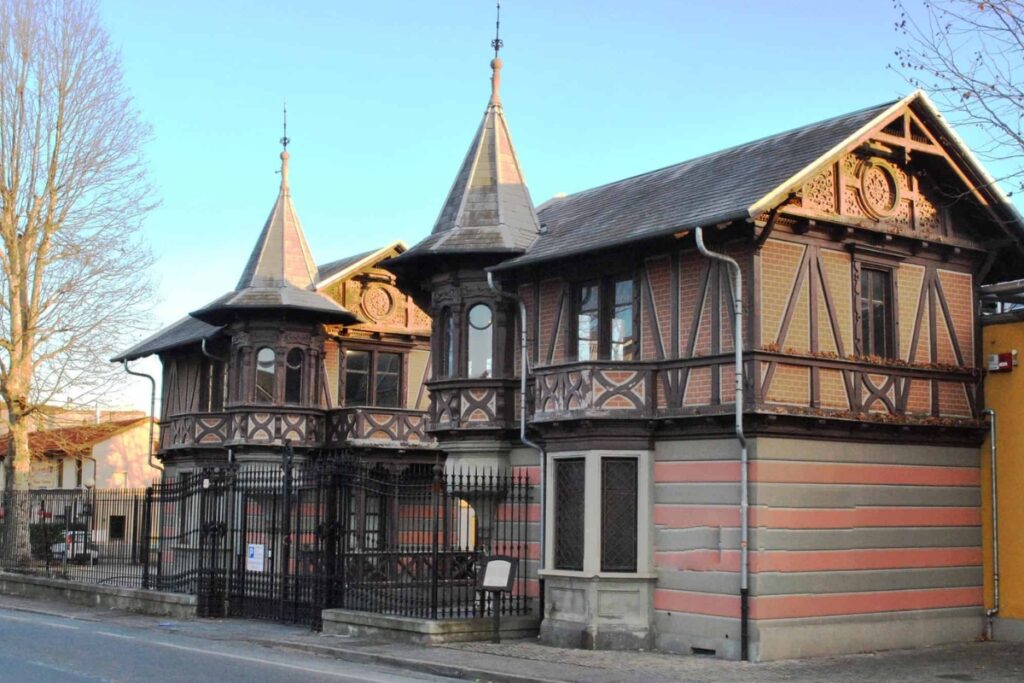
Villaggio Leumann
Step into Turin’s industrial past at Villaggio Leumann, a 19th-century workers’ village designed as a utopian community. Located in the Collegno district, this unique site features charming Art Nouveau-style homes, a church, and a school, all built by the visionary entrepreneur Napoleon Leumann. It’s a fascinating glimpse into Turin’s industrial history and an ideal spot for architecture enthusiasts.
Location: Corso Francia, 313, Collegno
PAV – Parco Arte Vivente
For a completely different experience, head to PAV (Living Art Park), an innovative blend of art, nature, and sustainability. This outdoor cultural space hosts installations and exhibitions focused on environmental themes. Wander through the park’s green spaces and interactive exhibits for a refreshing and thought-provoking escape from the city center.
Location: Via Giordano Bruno, 31, Turin
Turin’s hidden gems invite you to dig deeper into the city’s layered personality. From vibrant markets and tranquil churches to creative hubs and historic neighborhoods, these lesser-known spots promise an enriching and unforgettable experience for every traveler.
Turin Cuisine: A Feast for the Senses
Turin’s cuisine is a reflection of its regal history and rich cultural heritage, blending sophisticated flavors with hearty Piedmontese traditions. From signature pasta dishes to world-renowned chocolates, Turin offers a culinary experience that is both refined and comforting. Here’s a guide to the must-try culinary delights of Turin and where to find them.

Signature Dishes of Turin
Agnolotti del Plin
Agnolotti del Plin is one of Turin’s most iconic dishes, consisting of small, delicate pasta parcels stuffed with meat or vegetables. Traditionally served with butter and sage or a rich meat sauce, this dish embodies the warmth and heartiness of Piedmontese cooking. For an authentic taste, visit Porto di Savona on Piazza Vittorio Veneto, a historic trattoria known for its classic Piedmontese menu.
Location: Piazza Vittorio Veneto, 2
Vitello Tonnato
Vitello Tonnato, or veal with tuna sauce, is a quintessential Turin dish that combines thinly sliced, tender veal with a creamy, tangy tuna and caper sauce. Perfect as an appetizer or a light main course, it’s a must-try for foodies looking to experience unique flavor pairings. Try this dish at Ristorante Consorzio, a favorite among locals for traditional Piedmontese cuisine.
Location: Via Monte di Pietà, 23
Bagna Cauda
Bagna Cauda, meaning “hot dip,” is a communal dish of warm anchovy, garlic, and olive oil sauce served with an array of fresh vegetables for dipping. This flavorful and interactive dish is best enjoyed with friends or family. For an unforgettable Bagna Cauda experience, head to Tre Galline, one of Turin’s oldest restaurants.
Location: Via Bellezia, 37

Desserts and Sweet Treats
Gianduja
Turin is the birthplace of gianduja, the luxurious blend of chocolate and hazelnuts that inspired Nutella. Artisanal gianduja can be found in Turin’s historic chocolatiers like Guido Gobino, where you can sample creamy spreads and hazelnut-filled chocolates that are made with locally sourced ingredients.
Location: Via Lagrange, 1
Bicerin
Turin’s signature drink, bicerin, is a rich, indulgent concoction of espresso, hot chocolate, and cream, layered to perfection. It’s best enjoyed at Caffè Al Bicerin, the historic café where this iconic drink was first served in the 18th century. Pair it with a slice of hazelnut cake for the ultimate treat.
Location: Piazza della Consolata, 5
Panna Cotta
This silky, creamy dessert originated in the Piedmont region and is a staple on Turin’s dessert menus. Flavored with vanilla or topped with caramel or berry sauce, panna cotta is as comforting as it is elegant. Ristorante Circolo dei Lettori, located in a beautiful historic building, serves an exceptional version of this classic dish.
Location: Via Bogino, 9

Drinks and Aperitivo Culture
Vermouth
Turin is the birthplace of vermouth, a fortified wine infused with botanicals that plays a starring role in aperitivo culture. To taste the original, visit Casa Martini, where you can tour the historic vermouth distillery and enjoy expertly crafted cocktails.
Location: Piazza Luigi Rossi, 2, Pessione
Barolo and Barbera Wines
The Piedmont region is famous for its wines, especially Barolo and Barbera, which pair beautifully with Turin’s rich dishes. Many restaurants in the city, such as Enoteca Bordo, offer extensive wine lists featuring local vintages.
Location: Via Palazzo di Città, 21
Aperitivo
Turin’s aperitivo tradition is legendary, combining cocktails or vermouth with a buffet of small bites like cured meats, cheeses, and focaccia. One of the best places to experience aperitivo is Piazza Vittorio Veneto, home to numerous bars like Café Elena, where the aperitivo culture comes alive in the early evenings.
Location: Piazza Vittorio Veneto
Best Places to Dine in Turin
Turin offers a wide range of dining experiences, from fine dining to casual eateries and bustling markets. Del Cambio, one of Italy’s oldest restaurants, combines history with Michelin-starred cuisine, while Trattoria Valenza is perfect for a more rustic, home-style meal. For street food and local specialties, head to Porta Palazzo Market, the largest open-air market in Europe, where you can enjoy everything from freshly baked focaccia to local cheeses.

When to Experience Turin Cuisine
Turin’s cuisine shines year-round, with seasonal highlights that add extra charm to its flavors. Spring and summer bring fresh vegetables for Bagna Cauda and vibrant aperitivo spreads, while fall and winter are ideal for enjoying hearty dishes like agnolotti and creamy desserts. Visit during the annual Cioccolatò Festival in November to immerse yourself in Turin’s chocolate culture.
Turin’s culinary scene is a celebration of history, tradition, and innovation. Whether you’re sipping a velvety bicerin in a historic café or sharing a warm Bagna Cauda with friends, the flavors of Turin promise to leave a lasting impression on your palate and heart.
Where To Stay In Turin
Choosing the perfect place to stay in Turin can elevate your visit, whether you’re here to explore its rich history, savor its culinary delights, or admire its elegant architecture. Each neighborhood has its own unique charm, catering to a variety of interests, budgets, and travel styles. Here’s a detailed guide to the best areas and accommodations in Turin.

Centro (City Center)
The Centro is the heart of Turin, making it the ideal choice for first-time visitors. This area is home to iconic landmarks such as Piazza Castello, Palazzo Reale, and the Mole Antonelliana. With elegant arcaded streets, historic cafes, and luxury shopping options, the Centro offers a quintessential Turin experience.
The Centro is best for history buffs, art lovers, and first-time visitors who want to be within walking distance of Turin’s major attractions. Staying here immerses you in the city’s regal history, with easy access to museums, squares, and bustling nightlife.
For accommodations, Principi di Piemonte offers five-star luxury with sophisticated decor and spa facilities. Hotel Victoria Torino is a charming mid-range option known for its cozy interiors and relaxing spa. Budget travelers can enjoy a simple yet convenient stay at Hotel Bologna, just steps away from Porta Nuova train station.
Location: Piazza Castello and surrounding streets
San Salvario
San Salvario is one of Turin’s liveliest neighborhoods, known for its multicultural energy and thriving nightlife. This vibrant area is full of trendy bars, international restaurants, and unique shops, all within walking distance of Parco del Valentino, one of Turin’s largest green spaces.
San Salvario is best for young travelers, nightlife enthusiasts, and foodies who want to experience Turin’s dynamic and modern side. Its convenient location near Porta Nuova train station also makes it an excellent base for exploring the city.
For accommodations, Duparc Contemporary Suites offers modern, luxurious apartments with all the comforts of home. Hotel Urbani is a popular mid-range choice, providing stylish rooms close to public transport. Budget-conscious travelers can opt for Tomato Backpackers Hotel, a social and welcoming hostel with great amenities.
Location: South of Porta Nuova, near Parco del Valentino
Quadrilatero Romano
The Quadrilatero Romano combines ancient history with a bohemian vibe. This historic district features cobblestone streets, Roman ruins, and a mix of artisan shops and vintage boutiques. By night, it transforms into a vibrant hub of wine bars, cocktail lounges, and cozy restaurants.
Quadrilatero Romano is best for couples, creatives, and those seeking a blend of history and lively nightlife. Staying here offers a unique glimpse into Turin’s Roman heritage while enjoying its modern social scene.
For accommodations, NH Torino Santo Stefano offers upscale stays with a contemporary design and easy access to Porta Palatina. Albergo Antico Distretto is a mid-range choice with a homey atmosphere and great value. Budget travelers will appreciate Hotel Dogana Vecchia, Turin’s oldest hotel with charming historic decor.
Location: Between Piazza della Repubblica and Via Porta Palatina
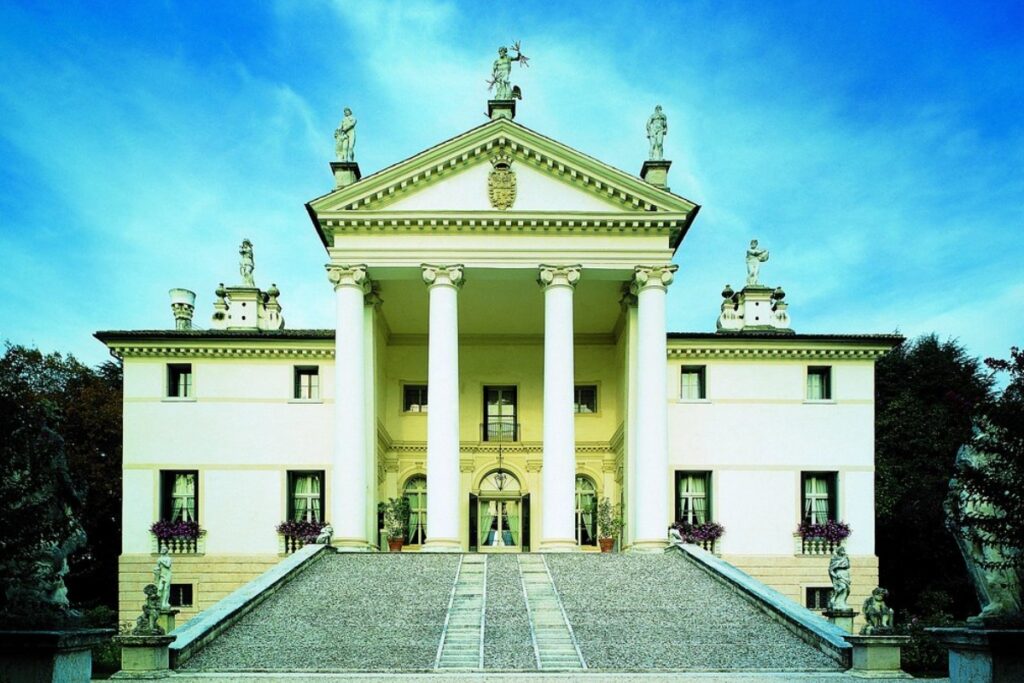
Crocetta
Crocetta is an upscale residential area that offers a peaceful retreat from Turin’s bustling city center. Known for its tree-lined streets and elegant architecture, it’s also home to the famous Crocetta Market, where visitors can shop for designer goods and local specialties.
Crocetta is best for families, luxury seekers, and travelers looking for a quieter stay. Its refined atmosphere and proximity to the city center make it an attractive option for those wanting a more laid-back experience.
For accommodations, DoubleTree by Hilton Turin Lingotto offers modern luxury in a historic Fiat factory setting. Hotel Lancaster is a stylish mid-range choice with excellent service and spacious rooms. Budget travelers can opt for Hotel Liberty, a cozy hotel with a welcoming vibe.
Location: South of the city center, near Corso Galileo Ferraris
Vanchiglia
Vanchiglia is Turin’s creative and artistic neighborhood, located just across the Po River. Its colorful streets are filled with galleries, independent shops, and trendy cafes, making it a favorite among locals and visitors seeking a more offbeat experience.
Vanchiglia is best for artists, creatives, and travelers looking for a neighborhood with a local vibe. Its proximity to the Mole Antonelliana and Piazza Vittorio Veneto makes it a perfect base for exploring Turin’s cultural highlights.
For accommodations, Hotel dei Pittori is a boutique hotel in an elegant Art Nouveau villa. Albergo Avalon provides mid-range charm with friendly service and uniquely decorated rooms. Budget travelers will enjoy Hotel Serenella, a simple yet comfortable option close to the Mole Antonelliana.
Location: East of the city center, near Piazza Vittorio Veneto and the Po River
Aurora
Aurora is an up-and-coming neighborhood just north of the city center. It’s home to Porta Palazzo Market, Europe’s largest open-air market, where visitors can experience Turin’s multicultural atmosphere and shop for fresh produce, artisan goods, and street food.
Aurora is best for budget travelers, market lovers, and those seeking an authentic local experience. Its mix of cultural influences and vibrant energy makes it an exciting and affordable area to stay in.
For accommodations, Combo Torino is a hip and modern hostel with stylish communal spaces and private rooms. Hotel Alexandra offers comfortable mid-range options with great views of the city. For a more budget-friendly stay, check out B&B Torino Crocetta, known for its welcoming ambiance.
Location: North of the city center, near Porta Palazzo
Turin’s neighborhoods cater to every type of traveler, from the historic charm of Centro to the artistic vibes of Vanchiglia. Whether you’re looking for luxury, nightlife, or a peaceful retreat, Turin’s diverse districts offer something for everyone.
Best Time To Visit Turin
Turin is a city that offers something special in every season, from snow-dusted streets in winter to lively festivals in summer. The best time to visit depends on your preferences for weather, activities, and events. Here’s a detailed guide to help you decide when to plan your trip.

Spring (March to May)
Spring in Turin is a magical time, with blooming flowers, mild weather, and a relaxed atmosphere. Temperatures range from 10°C to 20°C (50°F to 68°F), making it ideal for exploring the city on foot or enjoying its many parks and gardens.
Why Visit in Spring
• Perfect weather for outdoor activities, including strolling through Parco del Valentino or visiting the Basilica of Superga.
• Turin’s historic center, including Piazza Castello and the Mole Antonelliana, is less crowded.
• Experience Easter traditions and spring festivals, such as cultural events and flower markets in Piazza San Carlo.
Summer (June to August)
Turin’s summer is warm and vibrant, with temperatures often reaching 25°C to 30°C (77°F to 86°F). Although it’s a popular time for tourists, the city offers plenty of ways to stay cool, including riverside walks along the Po and shady streets under its famous arcades.
Why Visit in Summer
• Extended daylight hours allow for more time to explore landmarks like Palazzo Reale and the Egyptian Museum.
• Enjoy al fresco dining and aperitivo culture in lively piazzas like Piazza Vittorio Veneto.
• Perfect for day trips to the surrounding Piedmont countryside or wine regions like Langhe and Monferrato.
Fall (September to November)
Fall is arguably the best time to visit Turin. Temperatures range from 12°C to 22°C (54°F to 72°F), and the city takes on a golden glow. The crowds thin out, making it a peaceful yet lively time to explore.
Why Visit in Fall
• Comfortable weather for walking tours of Quadrilatero Romano or visiting the Shroud of Turin at the Cathedral of San Giovanni Battista.
• Turin’s restaurants highlight seasonal ingredients like truffles, mushrooms, and chestnuts, offering rich Piedmontese dishes.
• Participate in wine and food festivals, such as the Fiera Internazionale del Tartufo Bianco d’Alba (White Truffle Fair of Alba), just a short trip from Turin.

Winter (December to February)
Winter in Turin is mild compared to other European cities, with temperatures averaging 1°C to 8°C (34°F to 46°F). The festive holiday atmosphere and fewer tourists make it a cozy and magical time to visit.
Why Visit in Winter
• Experience Turin’s Christmas markets, illuminated streets, and the festive atmosphere in Piazza Castello.
• Explore the Egyptian Museum and Palazzo Madama with smaller crowds.
• Indulge in seasonal specialties like gianduja chocolates, bicerin, and warm polenta dishes.
Turin offers charm and excitement throughout the year, whether it’s spring blooms, summer energy, fall flavors, or winter festivities. No matter when you visit, you’ll find a city rich in history, culture, and culinary delights.
Fashion And Design In Turin: A Perfect Fusion Of Elegance And Innovation
Turin, Italy, is a city synonymous with understated sophistication, and this is reflected in its flourishing fashion and design scene. From its legacy of impeccable tailoring to modern design innovations, Turin blends traditional craftsmanship with contemporary creativity, making it a must-visit destination for fashion and design enthusiasts.
A Legacy Of Tailoring Excellence
Turin has long been associated with fine tailoring, rooted in its royal history and refined culture. Renowned ateliers throughout the city are celebrated for creating impeccably tailored garments. These bespoke pieces prioritize precision and timeless elegance, appealing to those who appreciate quality and individuality.
The area around Via Roma serves as a hub for high-end tailoring and luxury shopping. Iconic names like Carlo Alberto Tailors and other bespoke shops offer custom-made suits crafted from premium fabrics. Whether it’s a formal suit or a timeless coat, the city’s tailors combine artistry with functionality, embodying the spirit of Italian elegance.
Artisanal Accessories And Leatherwork
Beyond tailoring, Turin thrives in the world of artisanal craftsmanship. The city boasts an impressive array of family-run workshops specializing in handmade leather goods, custom footwear, and jewelry. These artisans carry on traditions passed down through generations, offering one-of-a-kind pieces that embody Turin’s dedication to craftsmanship.
Via Garibaldi, a pedestrian street in the heart of the city, is an excellent spot to discover handmade leather bags, belts, and shoes. For exquisite jewelry and unique fashion accessories, visit the charming boutiques tucked away in Galleria Subalpina, a historic arcade that showcases the best of Turin’s artisanal talent.
Turin’s Influence In Design
Turin’s passion for design goes beyond fashion, extending into industrial design, home decor, and contemporary art. As the birthplace of Fiat, Turin has long embraced the concept of combining aesthetics with practicality, a philosophy that continues to inspire its design community today.
One must-visit space is the Fondazione Sandretto Re Rebaudengo, a leading contemporary art and design center that highlights innovative works by Italian and international creators. Additionally, Turin hosts the Turin Design Festival, an annual celebration of creativity, featuring exhibitions and workshops that explore the intersection of tradition and modern design.
Where To Experience Turin’s Fashion And Design
For those seeking to immerse themselves in Turin’s fashion and design scene, explore these key areas:
• Via Roma: Known for luxury boutiques and tailoring houses offering bespoke garments.
• Via Garibaldi: A pedestrian-friendly street filled with artisan shops and leather goods.
• Galleria Subalpina: A historic arcade featuring exquisite jewelry and accessories.
• Fondazione Sandretto Re Rebaudengo: A contemporary art hub blending tradition and modernity.
Shopping And Taking Home A Piece Of Turin
Shopping in Turin is an experience rooted in discovery, where every piece tells a story. Whether it’s a bespoke jacket, handcrafted leather shoes, or an artisan-made accessory, each purchase embodies the city’s commitment to quality and artistry. For a casual shopping experience, Porta Palazzo Market offers a mix of local crafts and unique finds, making it easy to bring home a tangible memory of Turin’s creative spirit.
Turin’s fashion and design scene stands out for its authenticity and connection to its cultural heritage. From timeless tailoring to modern innovation, the city offers a personal and inspiring approach to style, leaving visitors captivated by its elegance and creativity.
Cultural Festivals And Events In Turin
Turin thrives on its rich history, artistic heritage, and innovative spirit, and this is beautifully reflected in the variety of festivals and events held throughout the year. From cultural celebrations to artistic showcases, these events invite both locals and visitors to experience Turin’s dynamic and creative energy.
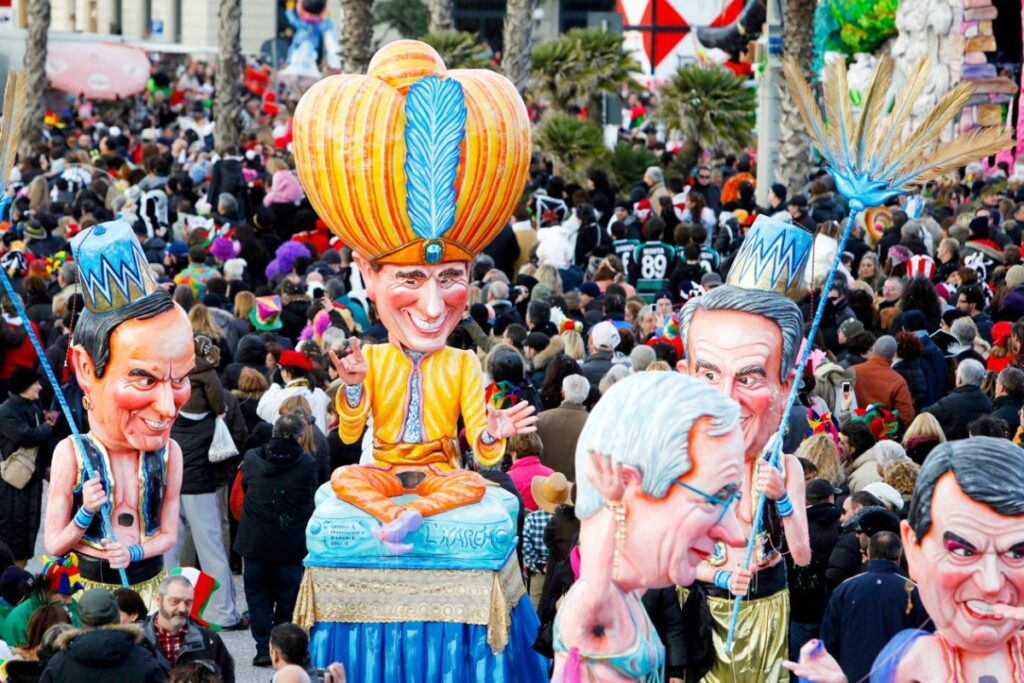
Major Festivals And Events
Torino Film Festival
One of Italy’s most prestigious film festivals, the Torino Film Festival is held every November, celebrating cinema with screenings of Italian and international films. Known for its focus on emerging filmmakers and innovative storytelling, the festival takes place in iconic venues like the Cinema Massimo. Film enthusiasts can enjoy a vibrant atmosphere while discovering groundbreaking works from around the world.
Cioccolatò
Turin’s love affair with chocolate comes to life every November during Cioccolatò, a festival dedicated to the city’s famed chocolate heritage. Visitors can indulge in tastings, workshops, and live demonstrations by master chocolatiers in Piazza San Carlo. From gianduja to artisanal pralines, this event is a paradise for chocolate lovers.
Settembre Musica (MITO Festival)
Held in September, MITO Settembre Musica is a renowned music festival that brings classical, jazz, and contemporary performances to venues across Turin. Concerts are hosted in breathtaking settings like the Teatro Regio di Torino, making this festival a highlight for music enthusiasts.

Seasonal Highlights
Easter Week
During Settimana Santa, or Holy Week, Turin hosts solemn and moving processions that reflect the city’s spiritual roots. Churches like the Cathedral of San Giovanni Battista offer special masses and ceremonies, and the Shroud of Turin is often a focal point of Easter reflections.
Torino Comics
Every spring, Torino Comics takes over the Lingotto Fiere exhibition center, celebrating pop culture, graphic novels, and gaming. This lively event attracts fans of all ages, featuring cosplay contests, artist meet-and-greets, and exhibitions from comic creators and publishers.
Luci d’Artista
During the winter months, Turin transforms into an open-air gallery with Luci d’Artista, a stunning display of artistic light installations across the city. Streets, squares, and historic landmarks like Piazza Castello are illuminated with creative works, blending art and technology in a magical winter celebration.

Art And Music Festivals
Torino Jazz Festival
Every April, the Torino Jazz Festival brings the city to life with performances by acclaimed jazz artists and emerging talents. Hosted in iconic venues like the Conservatorio Giuseppe Verdi, as well as outdoor stages, this festival captures Turin’s vibrant music scene.
Artissima
Artissima, held in November, is one of Italy’s leading contemporary art fairs. Hosted at the Oval Lingotto, it attracts collectors, curators, and art lovers from around the globe. With a focus on experimental and avant-garde works, Artissima is a testament to Turin’s innovative art scene.
Food And Cultural Events
Salone del Gusto
Organized by Slow Food, Salone del Gusto is a biennial event that celebrates sustainable and traditional food practices. Held in venues like the Lingotto Fiere, the festival features tastings, workshops, and conferences, connecting visitors to the rich culinary traditions of Turin and beyond.
Torino StrEat Festival
For street food enthusiasts, the Torino StrEat Festival offers a chance to savor the city’s culinary diversity. From regional specialties like agnolotti and gianduja treats to global street food delights, this vibrant event creates a delicious celebration in Turin’s open-air spaces.
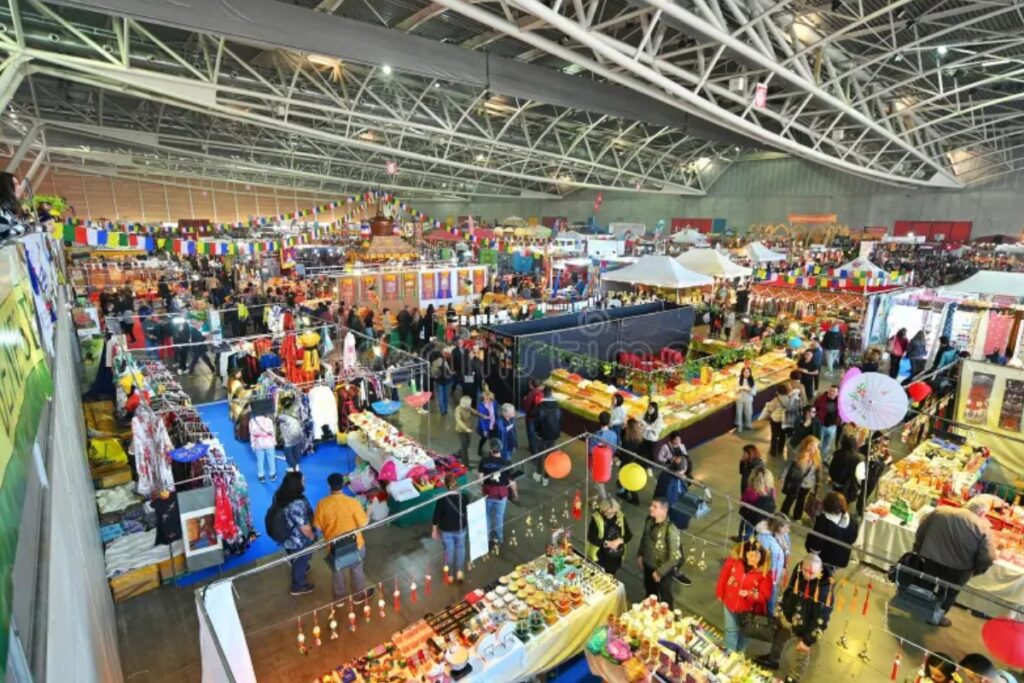
Celebrating Turin’s Culture Through Festivals
Turin’s festivals and events are more than just celebrations—they are an immersive journey into the city’s artistic, culinary, and cultural soul. Whether it’s the elegance of Artissima, the sweetness of Cioccolatò, or the cinematic brilliance of the Torino Film Festival, these gatherings highlight Turin’s ability to honor tradition while embracing modern creativity. Experiencing these events offers a deeper connection to the city’s unique charm and dynamic spirit.
Turin Travel Tips
Turin is a city of elegance, history, and culinary wonders, offering an unforgettable experience for travelers. To make the most of your trip, careful planning and local know-how can go a long way. Here are some detailed travel tips to help you enjoy Turin to the fullest.
Planning Your Visit
Research Events Ahead Of Time
Turin hosts remarkable events like the Torino Film Festival, Cioccolatò, and Luci d’Artista. If your visit aligns with these celebrations, book your accommodations and tickets in advance to secure your spot and make the most of these cultural highlights.
Best Time To Visit
The best times to visit Turin are spring (March to May) and fall (September to November), when the weather is mild, and the city is alive with festivals and activities. Summer can be warm, but the longer days are ideal for exploring. Winter offers festive charm with Christmas markets and magical light installations.
Stay In A Central Location
Choose accommodations in neighborhoods like Centro (City Center), San Salvario, or Vanchiglia. These areas keep you close to key attractions such as Piazza Castello, the Mole Antonelliana, and Parco del Valentino, while offering great dining and public transport options.
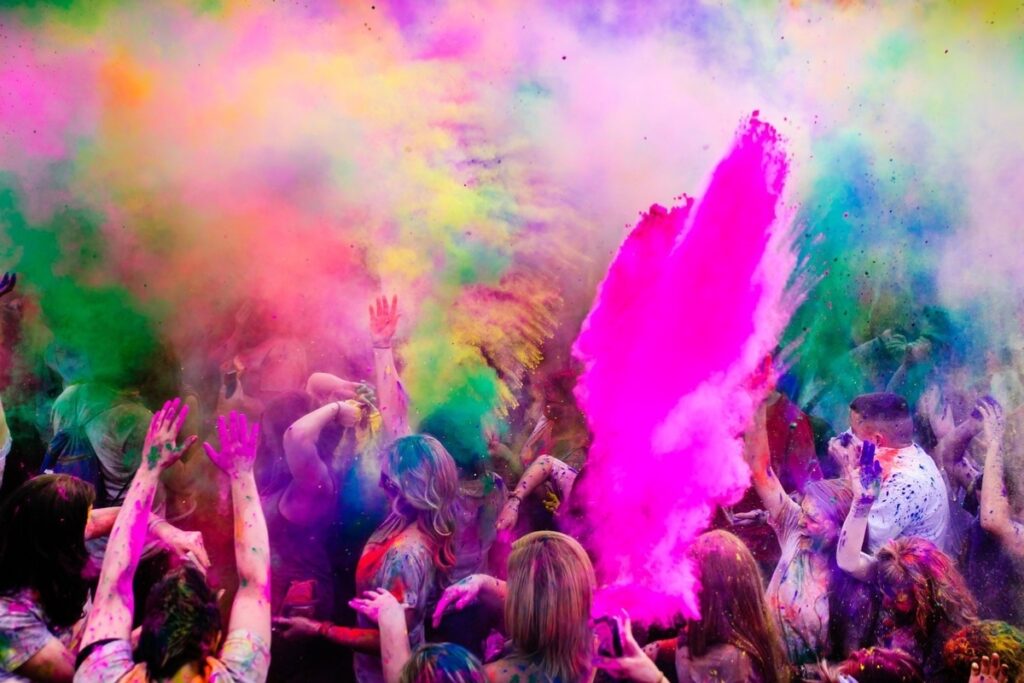
Getting Around Turin
Use Public Transportation
Turin has an efficient public transportation system, including buses, trams, and metro lines. A single ticket costs €1.70 and is valid for 100 minutes, while multi-day passes are convenient for frequent travel. Tickets must be validated on board to avoid fines.
Walk When Possible
Turin’s compact city center is best explored on foot. Walking lets you take in its arcaded streets, elegant piazzas, and hidden gems like boutique shops and historic cafes.
Be Cautious With Taxis
Taxis can be expensive in Turin. Always use official white taxis, check that the meter is running, or use ride-hailing apps like Free Now for reliable pricing.
Navigating Turin’s Attractions
Book Tickets In Advance
Popular sites like the Egyptian Museum, Mole Antonelliana, and Palazzo Reale can get busy, especially during weekends and peak seasons. Booking tickets online allows you to skip the lines and plan your visit more effectively.
Take Guided Tours
Guided tours of the Shroud of Turin, the Royal Residences, or the underground tunnels of the Porte Palatine provide fascinating insights into the city’s history. Many tours also include skip-the-line access and transportation.
Explore Beyond The City Center
Don’t limit yourself to the historic center. Visit neighborhoods like Crocetta for elegant streets and markets or Vanchiglia for its creative vibe. A trip to the Basilica of Superga, perched on a hill, rewards you with stunning views of the city and the Alps.
Dining And Shopping
Savor Authentic Piedmontese Cuisine
Try Turin’s regional dishes such as agnolotti del plin, vitello tonnato, and bagna cauda. Indulge in sweet treats like gianduja chocolate and bicerin at historic cafes like Caffè Al Bicerin. Avoid dining in tourist-heavy areas and opt for family-run trattorias for a more authentic experience.

Explore Local Markets
Markets like Porta Palazzo, Europe’s largest open-air market, and the Crocetta Market offer fresh produce, artisan goods, and local specialties. These bustling spots are perfect for sampling street food like farinata or grissini.
Shop For Artisanal Goods
Turin is known for its handcrafted items, including leather goods, fine chocolates, and jewelry. Visit artisan shops along Via Garibaldi or boutiques in Galleria Subalpina for unique souvenirs that capture Turin’s elegance.
Money And Budgeting
Currency And Payment
Turin uses the euro (€). Credit and debit cards are widely accepted, but it’s good to carry cash for small purchases at markets or family-run cafes.
Budgeting Tips
Save on transportation by walking or using multi-day transport passes. Museums like Palazzo Madama and the Egyptian Museum often offer discounted or free entry on the first Sunday of each month, making it easier to explore on a budget.
Pro Tips For A Smooth Trip
Start your day early to enjoy major attractions before the crowds. Pack comfortable shoes for walking on cobblestone streets and bring a reusable water bottle to refill at public fountains, as Turin’s tap water is clean and refreshing. Finally, embrace Turin’s relaxed pace—whether you’re sipping an aperitivo or exploring a quiet piazza, let the city’s elegance and charm guide your journey.
By planning ahead and following these tips, you’ll be well-prepared to enjoy Turin’s rich history, culinary delights, and sophisticated atmosphere.
FAQs About Traveling To Turin
How Many Days Should I Spend In Turin?
A 2 to 3-day trip is ideal for exploring Turin’s highlights. This gives you enough time to visit major attractions like the Mole Antonelliana, Egyptian Museum, Palazzo Reale, and Parco del Valentino, while still leaving room for leisurely strolls and indulging in the city’s culinary delights.
Is Turin Safe For Tourists?
Yes, Turin is generally safe for tourists. As with any large city, stay aware of your surroundings, especially in busy areas like Porta Nuova station and markets like Porta Palazzo. Keep your belongings secure and avoid poorly lit or isolated areas at night.
Can I Visit The Egyptian Museum And Mole Antonelliana In One Day?
Yes, it’s absolutely possible to visit both the Egyptian Museum and Mole Antonelliana in one day, as they’re located within walking distance in the city center. To save time, book tickets online in advance, especially for the Mole Antonelliana, which can have long queues.
What Is The Best Way To Get Around Turin?
Turin is a walkable city, especially in the historic center. For longer distances, the city’s efficient public transportation system—including buses, trams, and metro lines—is the best option. Tickets cost €1.70 and are valid for 100 minutes. Taxis and ride-hailing apps like Free Now are also available but are more expensive.
What Language Is Spoken In Turin?
Italian is the official language spoken in Turin. Many locals, especially in tourist areas, speak some basic English. However, learning a few Italian phrases, like “buongiorno” (good morning) and “grazie” (thank you), can go a long way in making your interactions more pleasant.
Is Tap Water Safe To Drink In Turin?
Yes, tap water in Turin is safe to drink. The city’s water comes from natural springs in the Alps, making it fresh and clean. Public fountains, called “toret,” are scattered throughout Turin and provide free drinking water, so carrying a reusable bottle is a great idea.
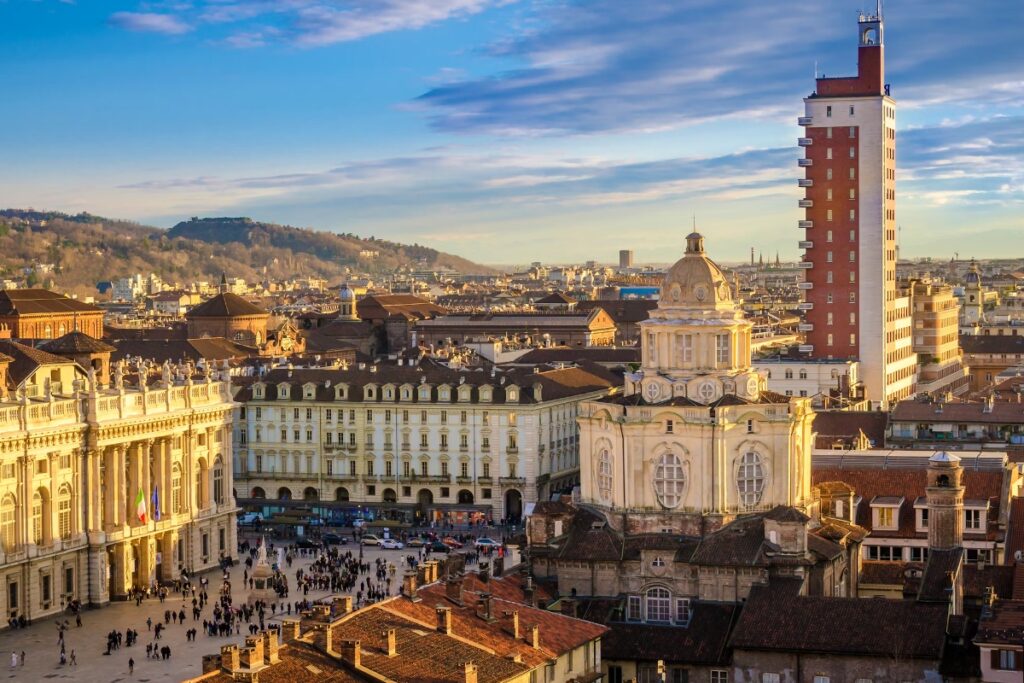
Conclusion
The city’s vibrant neighborhoods, like the creative Vanchiglia and the lively San Salvario, add layers of personality to its already dynamic character. Meanwhile, its festivals, markets, and artisanal traditions ensure that every visitor finds something meaningful to experience.
Turin’s balance of tradition and modernity creates a city that feels both timeless and forward-thinking. Whether you’re a history buff, foodie, or art lover, Turin promises an unforgettable journey into the heart of Italian culture.
As you leave Turin, you’ll take with you memories of its elegance, flavors, and welcoming atmosphere—along with a longing to return to uncover even more of its hidden gems. Turin truly is a city that leaves a lasting impression.




